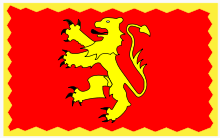Rhys ap Tewdwr
Rhys ap Tewdwr (before 1065 – 1093) was a king of Deheubarth in Wales and member of the Dinefwr dynasty, a branch descended from Rhodri the Great. He was born in the area which is now Carmarthenshire and died at the battle of Brecon in April 1093.
Family

Rhys ap Tewdwr, a member of the House of Dinefwr, claimed the throne of Deheubarth following the death of his second cousin Rhys ab Owain, who was beheaded after the battle of Gwdig (modern day Goodwick) against Caradog ap Gruffydd in 1078.
He was a grandson of Cadell ab Einion ab Owain ab Hywel Dda, and a great-grandson of Einon ab Owain, thus a descendant of Hywel Dda, king of the Britons.[1]
He married Gwladys ferch Rhiwallon daughter of Rhiwallon ap Cynfyn of the Mathrafal dynasty of Powys, by whom he had four sons, Gruffudd, Hywel ap Rhys, Goronwy and Cadwgan, and a daughter Nest who married Gerald de Windsor, Constable of Pembroke, progenitors of the FitzGerald and de Barry dynasties of Ireland. These Hiberno-Norman, or Cambro-Norman, families have been Peers of Ireland since at least the 14th century.
The English variant of Tewdwr is Tudor. Henry Tudor, King of England was a matrilineal descendant of Rhys ap Tewdwr.
Early rule
In 1081 Caradog ap Gruffydd invaded Deheubarth and drove Rhys to seek sanctuary in the St David's Cathedral.
Rhys however made an alliance with Gruffudd ap Cynan who was seeking to regain the throne of the Kingdom of Gwynedd, and at the Battle of Mynydd Carn in the same year they defeated and killed Caradog ap Gruffydd and his allies Trahaearn ap Caradog of Gwynedd and Meilyr ap Rhiwallon.
Norman homage
The same year William the Conqueror visited Deheubarth, ostensibly on a pilgrimage to St David's, but with a major show of power as well, traversing the width of southern Wales, and it seems likely he came to an arrangement with Rhys, whereby Rhys paid him homage and was confirmed in possession of Deheubarth. Rhys paid William £40 a year for his kingdom, ensuring good future relations with William that lasted until the end of his lifetime. Rhys was content with the arrangement as it meant that he only had to deal with the jealousy of his fellow Welsh princes.
Internal conflict
In 1088 Cadwgan ap Bleddyn of Powys attacked Deheubarth and forced Rhys to flee to Ireland. However, Rhys returned later the same year with a fleet from Ireland and defeated the men of Powys, in a battle in which two of Cadwgan's brothers, Madog and Rhiryd, were killed.
In 1091 he faced another challenge in the form of an attempt to put Gruffydd, the son of Maredudd ab Owain, on the throne of Deheubarth. Rhys was able to defeat the rebels in a battle at St. Dogmaels, killing Gruffydd.
Death
Rhys was unable to withstand the increasing Norman pressure. The Welsh Bruts state that "Rhys ap Tewdwr, king of Deheubarth, was slain by the Frenchmen who were inhabiting Brycheiniog." The Brut y Tywysogion adds and with him fell the kingdom of the Britons. This passage lends evidence to the belief that the conquest of Brycheiniog (Brecon), led by Bernard de Neufmarche, was mostly finished by Eastertide 1093. The battle of Brecon opened the way to the conquest of Deheubarth.
Succession
Upon Rhys's death, the Normans seized much of south Wales, and fighting over the spoils with the chieftains of Powys and Gwynedd. Eventually, Rhys's eldest son, Gruffydd, was allowed to inherit a small portion of his father's kingdom. Rhys's daughter Nest was briefly one of the numerous concubines of Henry I, to whom she bore a son, and thereafter the wife of Gerald FitzWalter of Pembroke; their sons and grandsons, the FitzGerald conquerors of Ireland, were known collectively as the "sons of Nest". Through his son Gruffydd, Rhys was an ancestor of the Tudor dynasty.
Ancestry
| Ancestors of Rhys ap Tewdwr | ||||||||||||||||||||||||||||||||||||||||||||||||||||||||||||||||||||||||||||||||||||||||||||||||||||||||||||||||||||||||||||||||||||||||||||||||||||||||||||||||||||||||||||||||||||||||||||||||||||||||||||||||||||||||||||||||||||||||||||||||
|---|---|---|---|---|---|---|---|---|---|---|---|---|---|---|---|---|---|---|---|---|---|---|---|---|---|---|---|---|---|---|---|---|---|---|---|---|---|---|---|---|---|---|---|---|---|---|---|---|---|---|---|---|---|---|---|---|---|---|---|---|---|---|---|---|---|---|---|---|---|---|---|---|---|---|---|---|---|---|---|---|---|---|---|---|---|---|---|---|---|---|---|---|---|---|---|---|---|---|---|---|---|---|---|---|---|---|---|---|---|---|---|---|---|---|---|---|---|---|---|---|---|---|---|---|---|---|---|---|---|---|---|---|---|---|---|---|---|---|---|---|---|---|---|---|---|---|---|---|---|---|---|---|---|---|---|---|---|---|---|---|---|---|---|---|---|---|---|---|---|---|---|---|---|---|---|---|---|---|---|---|---|---|---|---|---|---|---|---|---|---|---|---|---|---|---|---|---|---|---|---|---|---|---|---|---|---|---|---|---|---|---|---|---|---|---|---|---|---|---|---|---|---|---|---|---|---|---|---|---|---|---|---|---|---|---|---|---|---|---|---|
| ||||||||||||||||||||||||||||||||||||||||||||||||||||||||||||||||||||||||||||||||||||||||||||||||||||||||||||||||||||||||||||||||||||||||||||||||||||||||||||||||||||||||||||||||||||||||||||||||||||||||||||||||||||||||||||||||||||||||||||||||
Footnotes
- ↑ A history of Wales from the earliest times to the Edwardian conquest, Volume 2
References
- The Welsh Academy Encyclopaedia of Wales, University of Wales Press, 2008, ISBN 978-0-7083-1953-6
- Remfry, P.M., A Political Chronology of Wales 1066 to 1282 (ISBN 1-899376-46-1)
- A history of Wales from the earliest times to the Edwardian conquest, Volume 2, John Edward Lloyd, 1911
| Preceded by Rhys ab Owain |
Prince of Deheubarth 1078–1093 |
Succeeded by Gruffydd ap Rhys |